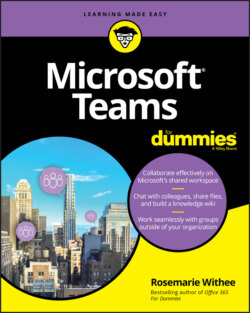Читать книгу Microsoft Teams For Dummies - Rosemarie Withee - Страница 16
На сайте Литреса книга снята с продажи.
Managing Your Team Settings
ОглавлениеYou can control many different settings in Teams, such as adding and configuring channels, users, and chat behavior, and you will discover how to change these settings in the next section. The settings you will likely use the most frequently are for your specific teams. These include adding and removing owners, members, and guests; adding and deleting channels; and working with apps.
To open the settings for a team, click the ellipsis next to the name of the team to open the more options drop-down menu (shown earlier in Figure 3-8) and select Manage Team.
The settings screen for a team contains the following tabs at the top, as shown in Figure 3-9:
Members: The Members screen is where you add new members to the team. You can add people as members of the team or as guests. A guest user is a user who has access to Teams and can chat with you, but does not have access to the rest of your Office 365 ecosystem. I cover guest user access in detail in Chapter 7.
Channels: The Channels screen is where you can add a channel. A channel is an area of a team where you can chat about a common topic. For example, you might have a channel for carpooling, a channel for accounting, and a channel for clients. I cover channels in Chapter 4.
Settings: The Settings screen is where you manage the settings for a team, as shown in Figure 3-10. On the Settings screen you can set the team picture, set the permissions of users including what permissions you want to give to guest users, set how @mentions work (pronounced “at mentions”), get a link to the team that you can share so others can join the team, and other fun stuff such as adding virtual stickers.FIGURE 3-9: The management screen for a team with the Members tab open.FIGURE 3-10: The Settings screen is where you can control team settings. An @mention is when someone uses the @ (“at”) symbol followed by the name of a user in a message. It is essentially tagging the person so that Teams knows who the person is that is being mentioned. When your name is @mentioned, you will get a notification that someone has mentioned your name in a message. This will help you scroll through and find messages that are pertinent to you. I cover mentions and feeds in Chapter 8.
Apps: The Apps screen is where you can add apps to the team. You can see that some apps are installed by default. You can also add more by clicking the More Apps button. I cover apps in Chapter 5.
